Stan Store vs Etsy: Definitive Comparison [July 2025]
![Stan Store vs Etsy: Definitive Comparison [July 2025]](https://wp.sellfy.com/blog/wp-content/uploads/2024/09/Satan-Store-vs-Etsy.png)
After testing and comparing Stan Store and Etsy over the past few weeks, it became obvious that each platform caters to different types of sellers and has unique features tailored to specific needs:
Stan Store is more suitable for creators and influencers who need a platform to sell digital products, subscriptions, or services directly to their audience. Its intuitive design allows for quick setup and easy integration with social media, making it perfect for those who prioritize speed and simplicity over extensive customization.
Etsy, on the other hand, is well-suited for artisans, makers of handcrafted goods, and vintage enthusiasts. In contrast to Stan Store, Etsy is a robust marketplace with a built-in audience actively searching for unique, creative products. However, with Etsy’s emphasis on community and discovery, sellers must compete within a crowded marketplace, which may require more effort to stand out.
Since each platform lacks a comprehensive blend of robust eCommerce features, customization, and ease of use, I’ve included Sellfy in this comparison. With its support for both digital and physical products, customizable store templates, and an impressive list of built-in marketing tools, Sellfy offers a versatile platform that caters to a wide range of creators. Its ease of use, combined with the ability to fully brand your store and manage customer interactions, makes it an excellent choice for those who want more control and flexibility over their selling experience while still maintaining simplicity and efficiency.
Let’s take a deeper dive into Stan Store vs Etsy vs Sellfy to understand how they differ in the following key areas:
- Creating an online store
- Marketing ad eCommerce features
- Customization and design
- Pricing and transaction fees
We’ll also discuss ease of use, customer support, and other features in the comparison table below to give you a comprehensive overview of each platform.
Sellfy | Shopify | Stan |
Price | ||
| ⭐️⭐️⭐️ | ⭐️⭐️⭐️⭐️ |
Creating an online store | ||
| ⭐️⭐️⭐️ | ⭐️⭐️⭐️⭐️ |
Marketing features | ||
| ⭐️⭐️ | ⭐️⭐️⭐️ |
Customization and design | ||
⭐️⭐️⭐️⭐️⭐️ | ⭐️⭐️⭐️ | ⭐️⭐️⭐️⭐️ |
Ease of use | ||
⭐️⭐️⭐️⭐️⭐️ | ⭐️⭐️⭐️⭐️⭐️ | |
Customer support | ||
⭐️⭐️⭐️⭐️⭐️ | ⭐️⭐️⭐️⭐️ | ⭐️⭐️⭐️⭐️ |
Best for | ||
Creators and entrepreneurs looking for a full control over their store and branding. Ideal for selling digital and physical products, subscriptions, and memberships from a fully customizable online store. | Artists and creators selling handmade, vintage, or unique items looking for a simple setup, access to a large marketplace, and no need for a standalone and customized store. | Social media influencers and creators looking for a combination eCommerce with a link-in-bio platform. Ideal for Instagram and TikTok users wanting a simple hub to sell digital products ans services. |
Want to explore more options? Check out our guides on Stan Store alternatives and Etsy alternatives to compare other platforms that might better suit your needs.
What is Stan Store?
“Create, connect, and sell—all in one place” 🔗🛒

Launched in 2022, Stan Store helps digital creators and influencers seamlessly sell downloads, memberships, and other digital products directly to their audience. Today, it’s used by over 100,000 users, making it one of the fastest-growing platforms for creator-driven commerce.
Stan Store offers a host of eCommerce features, including easy integration with social media, and basic analytics tools, allowing users to manage sales, engage with the audience, and track their performance in real-time. Plus, Stan Store supports a wide range of digital products, as they don’t offer a way to sell physical products at this time.
The simple and user-friendly UI makes Stan Store great for creators, influencers, and small businesses looking to monetize their creativity and engage with their followers more effectively. However, the simplicity and focus on individual creators may not be suitable for some creators and businesses looking for advanced customization or a more robust eCommerce toolkit.
What is Etsy?
“A place to sell handmade, custom, and unique things” 🛍️✨
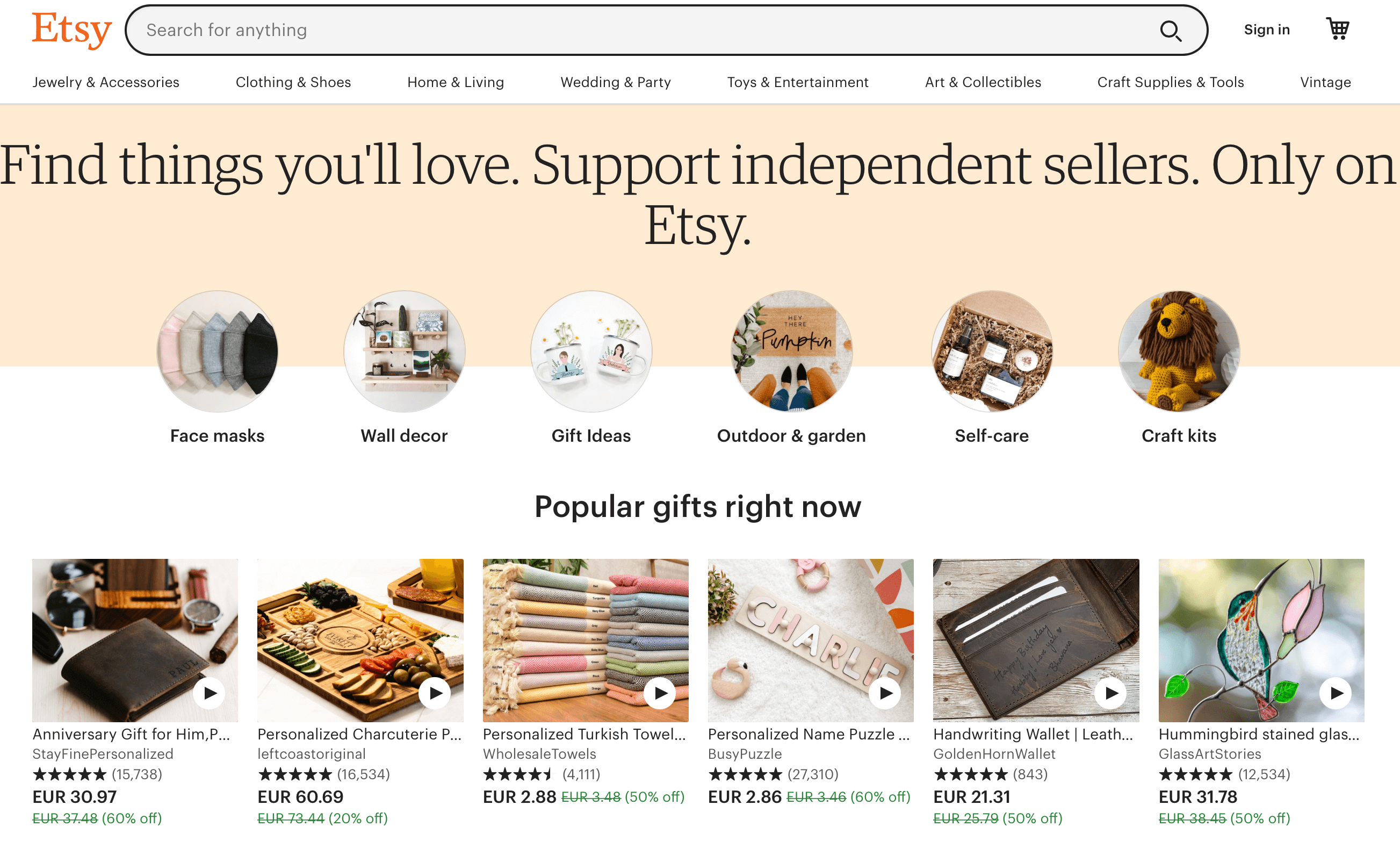
Launched in 2005, Etsy allows artists and vintage sellers to showcase and sell their unique handmade and vintage goods directly to a global audience. Today, it’s used by millions of users, making it one of the most popular online marketplaces.
Etsy offers a variety of features, including an easy-to-use interface for listing items, integrated payment processing, and basic analytics tools, allowing you to manage your Etsy shops and track their performance. Plus, Etsy is a highly community-oriented platform with forums and teams that help sellers connect and help each other out.
This user-friendly and community-driven experience makes Etsy great for small business owners, independent creators, and hobbyists looking to reach a niche market and engage with a community of like-minded buyers and sellers. However, if you’re looking to sell mass-produced or even digital products, Etsy might not be the best fit due to its focus on handmade and vintage goods. Plus, Etsy’s fees and limited customization options can be a downside for businesses that want a more flexible or budget-friendly eCommerce solution.
What is Sellfy?
“Your one-stop shop for effortless online sales” 🛒✨
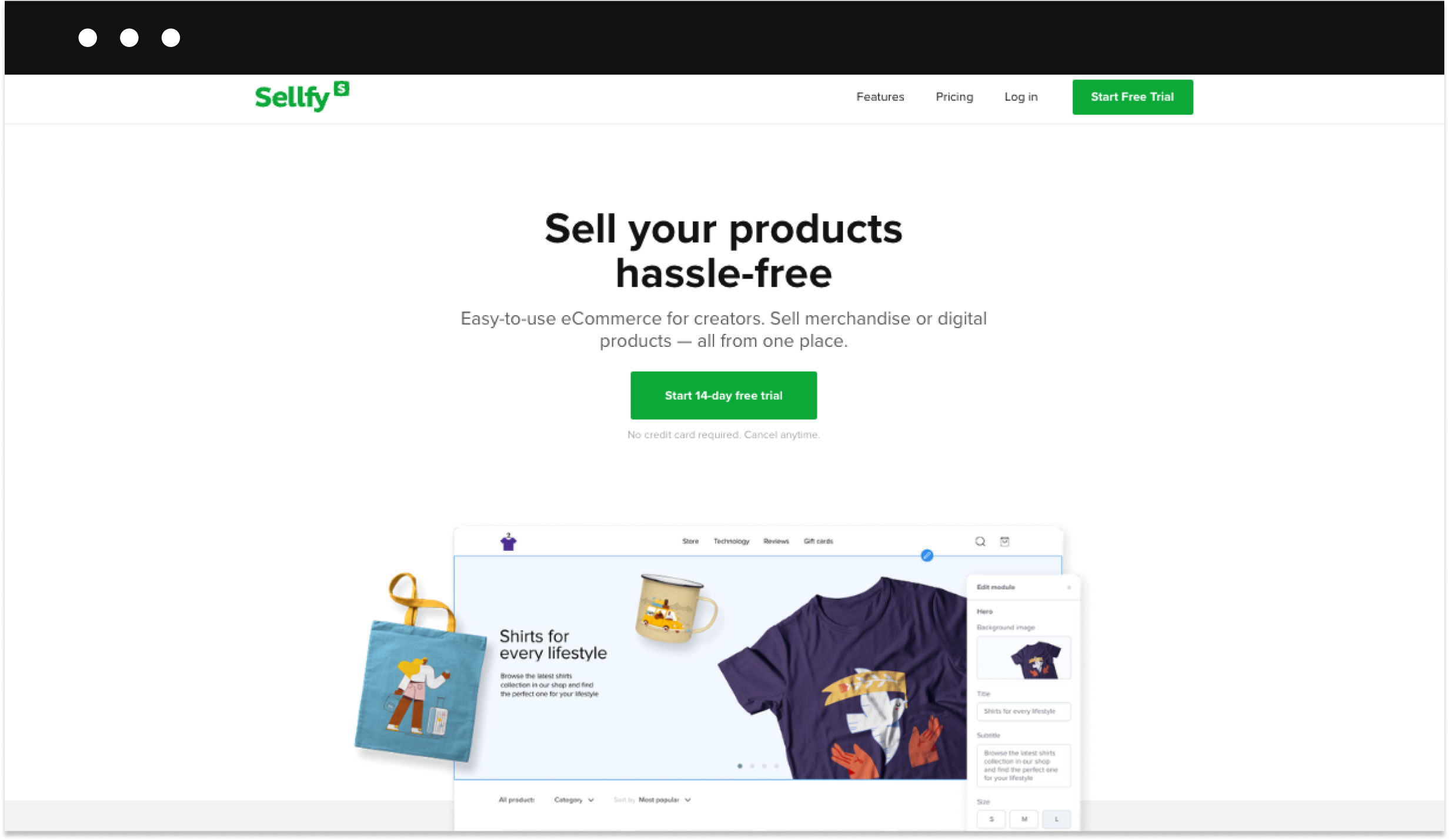
Launched in 2011, Sellfy started as a platform for selling digital downloads and quickly became a leader in that niche. Now, it’s an all-in-one eCommerce platform designed to help creators, artists, and small businesses sell digital products, physical goods, subscriptions, and even print-on-demand items from your online store. Today, it’s used and trusted by thousands of users worldwide, making it a popular choice for anyone looking to monetize their audience, content, or skills quickly and easily.
Sellfy offers a rich suite of eCommerce features, including customizable store templates, advanced store analytics, and built-in marketing tools. Plus, Sellfy supports a variety of products, from digital downloads to subscriptions and custom merch, allowing users to diversify their income streams.
The straightforward and beginner-friendly experience makes Sellfy ideal for new creators and established businesses looking for a simple yet effective way to start selling online. The best part? You can start selling in under 10 minutes by uploading your first product, customizing your store theme, connecting a payment method, and you’re ready to go.
Stan Store vs Etsy vs Sellfy: Creating an online store
While Etsy is a creative marketplace with a 20MB cap on digital product sizes and a strong brand presence, Stan Store and Sellfy function as eCommerce platforms offering more product options, higher digital product size caps of 4GB and 15GB, respectively, and in the case of Sellfy, the ability to create a completely white-labeled store.
 | ||
⭐️⭐️⭐️⭐️⭐️ | ⭐️⭐️⭐️ | ⭐️⭐️⭐️⭐️ |
Stan Store and Sellfy are eCommerce platforms, while Etsy is a creative marketplace
An all-in-one eCommerce platform is like a Swiss Army knife for selling online—it gives you everything in one place: a website, payment processing, inventory tracking, and marketing tools, so you don’t have to juggle a bunch of different systems to run your business.
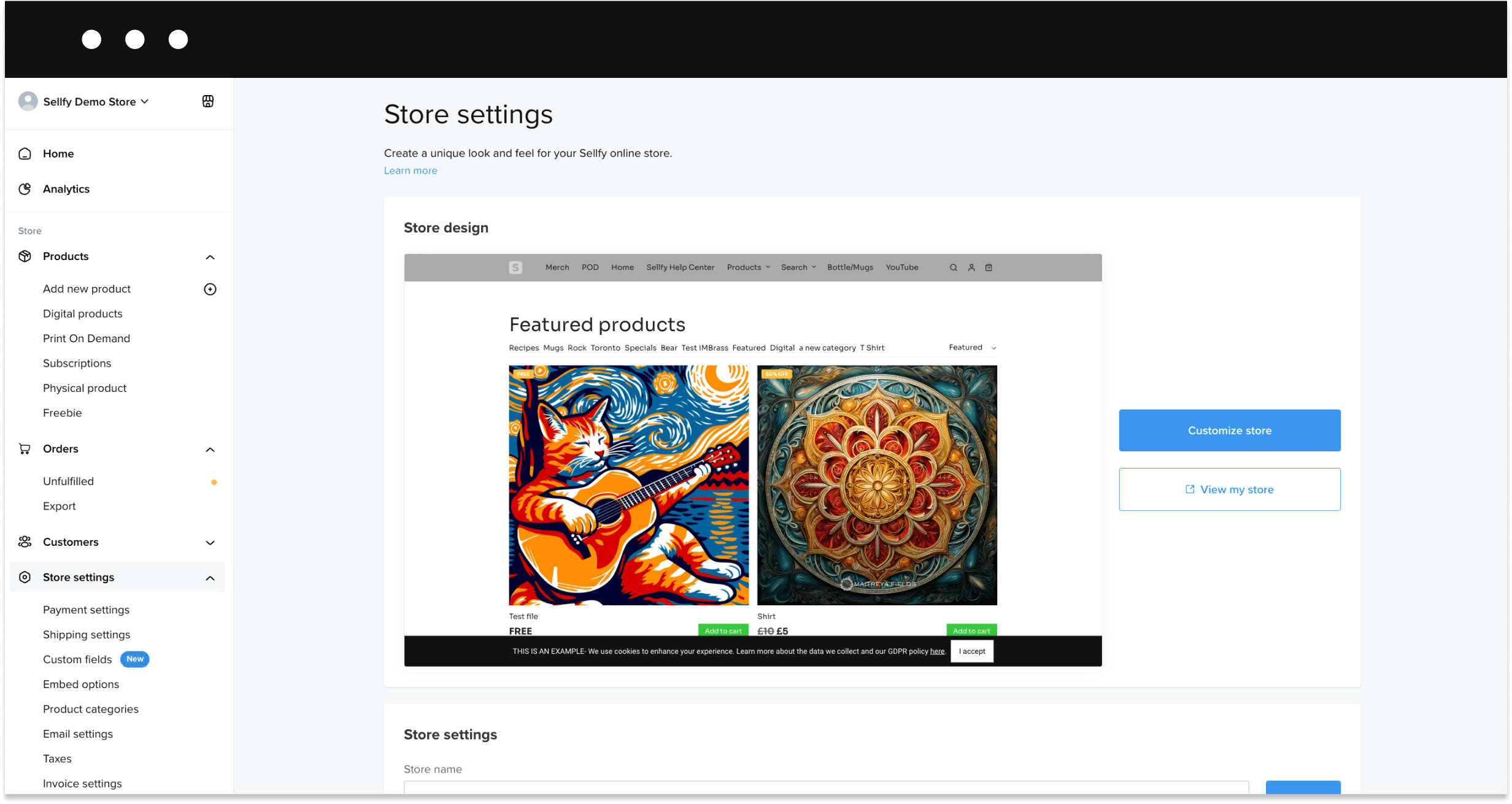
Stan Store and Sellfy are both eCommerce platforms for creators looking to sell a wide range of digital and physical products. There are still quite different, while Sellfy allows you to create a standalone online store for your products and are much more flexible in terms of product types, Stan Store is more of a creator monetization platform that uses a link-in bio landing page as well as a storefront.
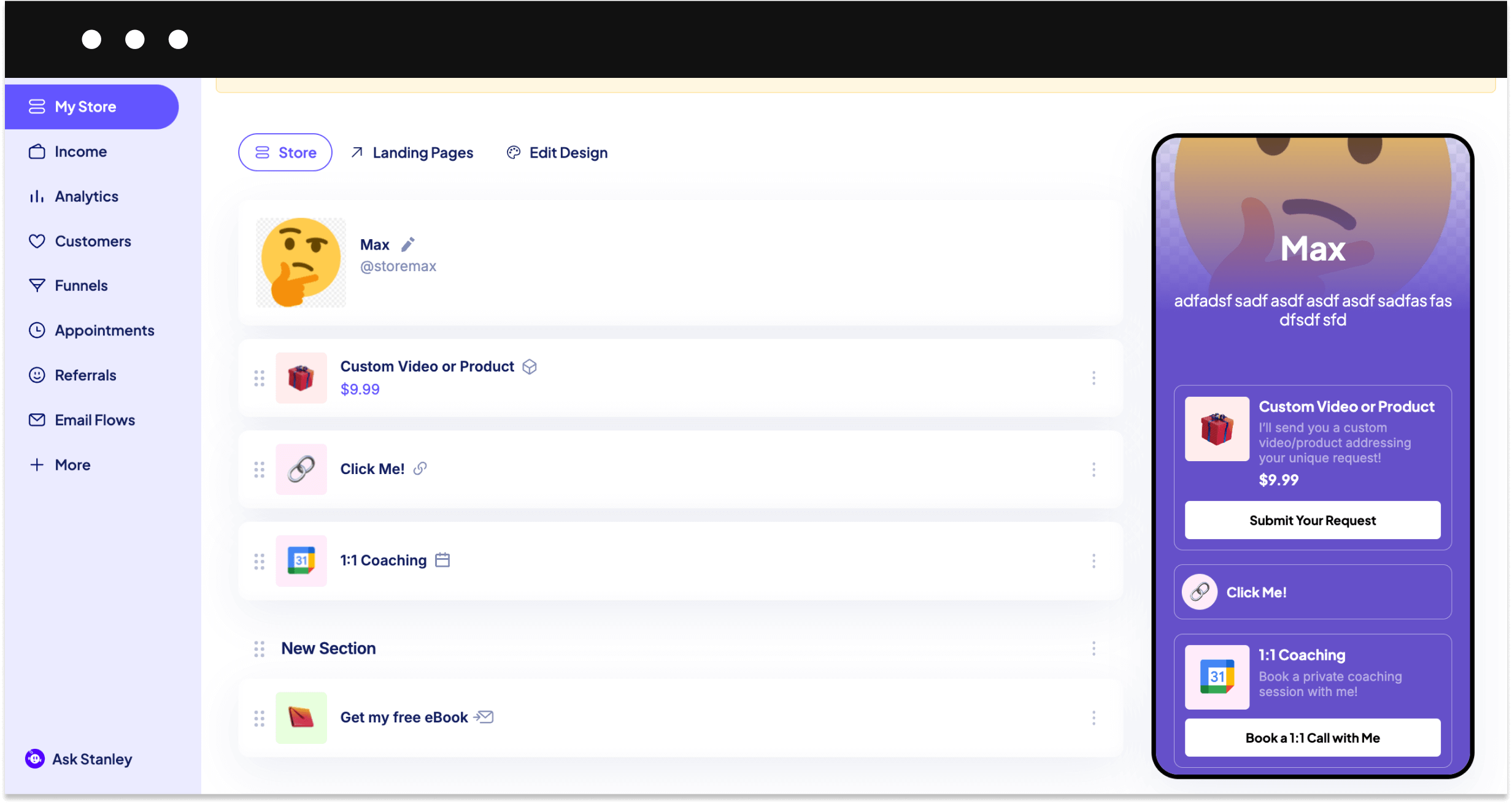
Unlike Etsy, which is primarily a popular creative marketplace (well, not so popular in 2024) that lets artisans and creatives open an online for handmade, vintage, and unique items.
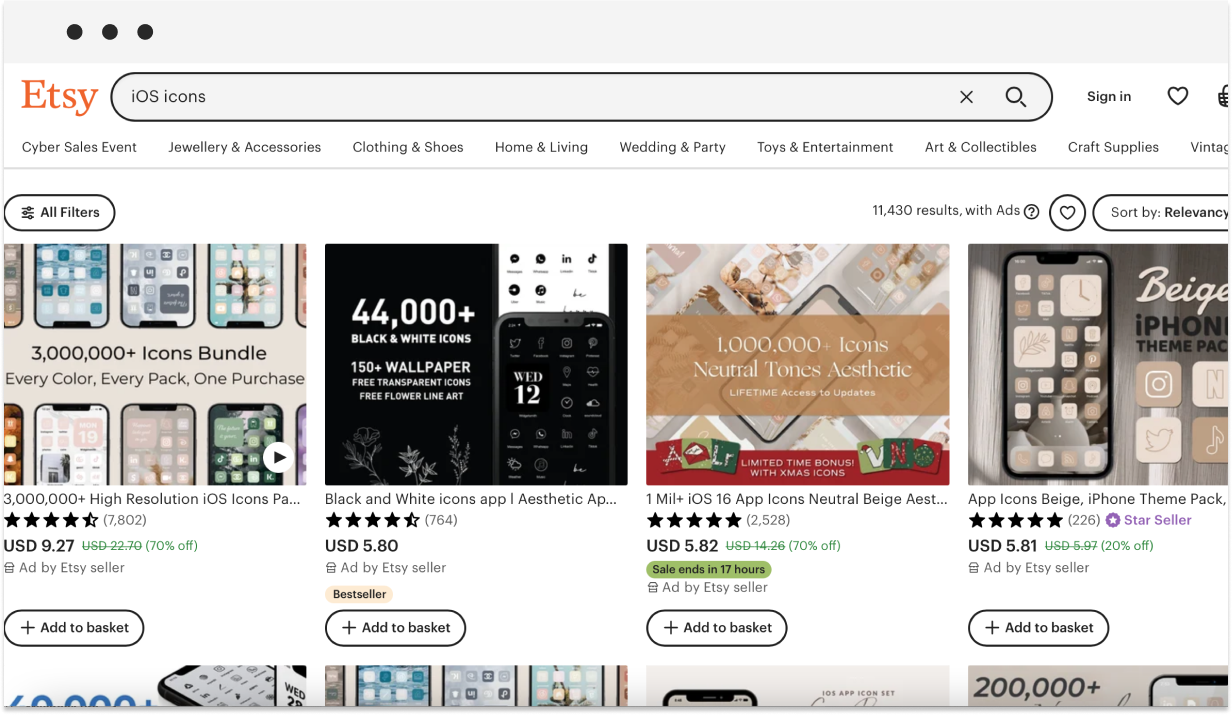
Stan Store and Sellfy allow sellers to offer various products, from digital downloads to subscriptions, and even physical goods. This combined with a richer list of eCommerce tools makes them ideal for businesses looking to diversify their product offerings beyond the creative sector.
Don’t get me wrong, Etsy is a great platform, but its setup is just very different from eCommerce platforms like Stan Store and Sellfy. Plus, while Etsy’s marketplace format inherently includes competition with other sellers, it still has one key advantage over Stan Store and Sellfy—an established customer base. With Etsy, you don’t need to have an existing social media following to make sales.
Etsy lets you sell downloads, Sellfy and Stan Store offer much more product options
Apart from physical handcrafted and vintage items, Etsy allows sellers to offer digital downloads, making it a great choice for creators selling digital art, printables, patterns, and other downloadable products.
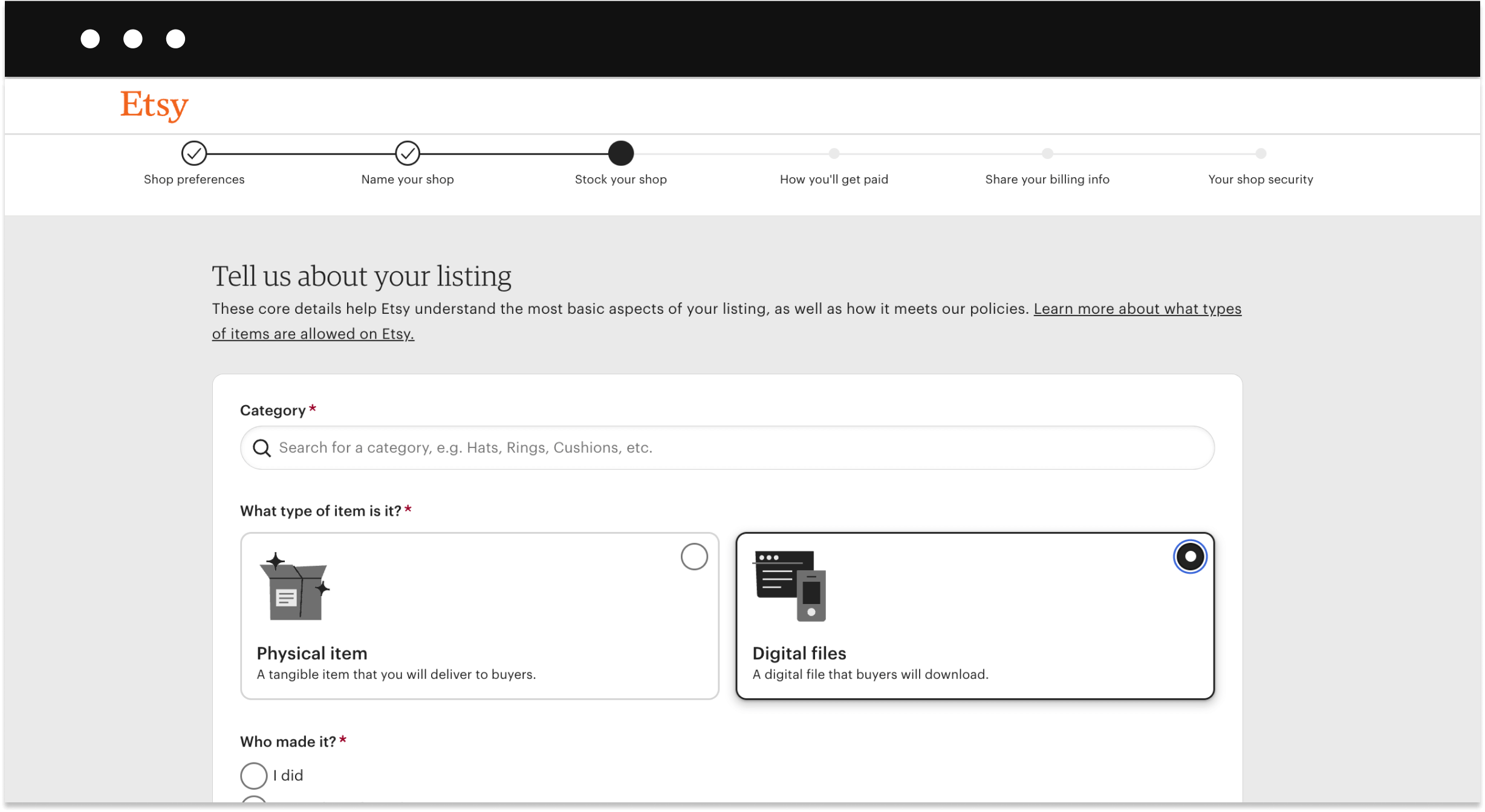
At the same time, Sellfy and Stan Store provide greater flexibility by supporting not only digital downloads but also subscriptions, memberships, physical products, and in the case of Sellfy even VOD and custom print-on-demand merch.
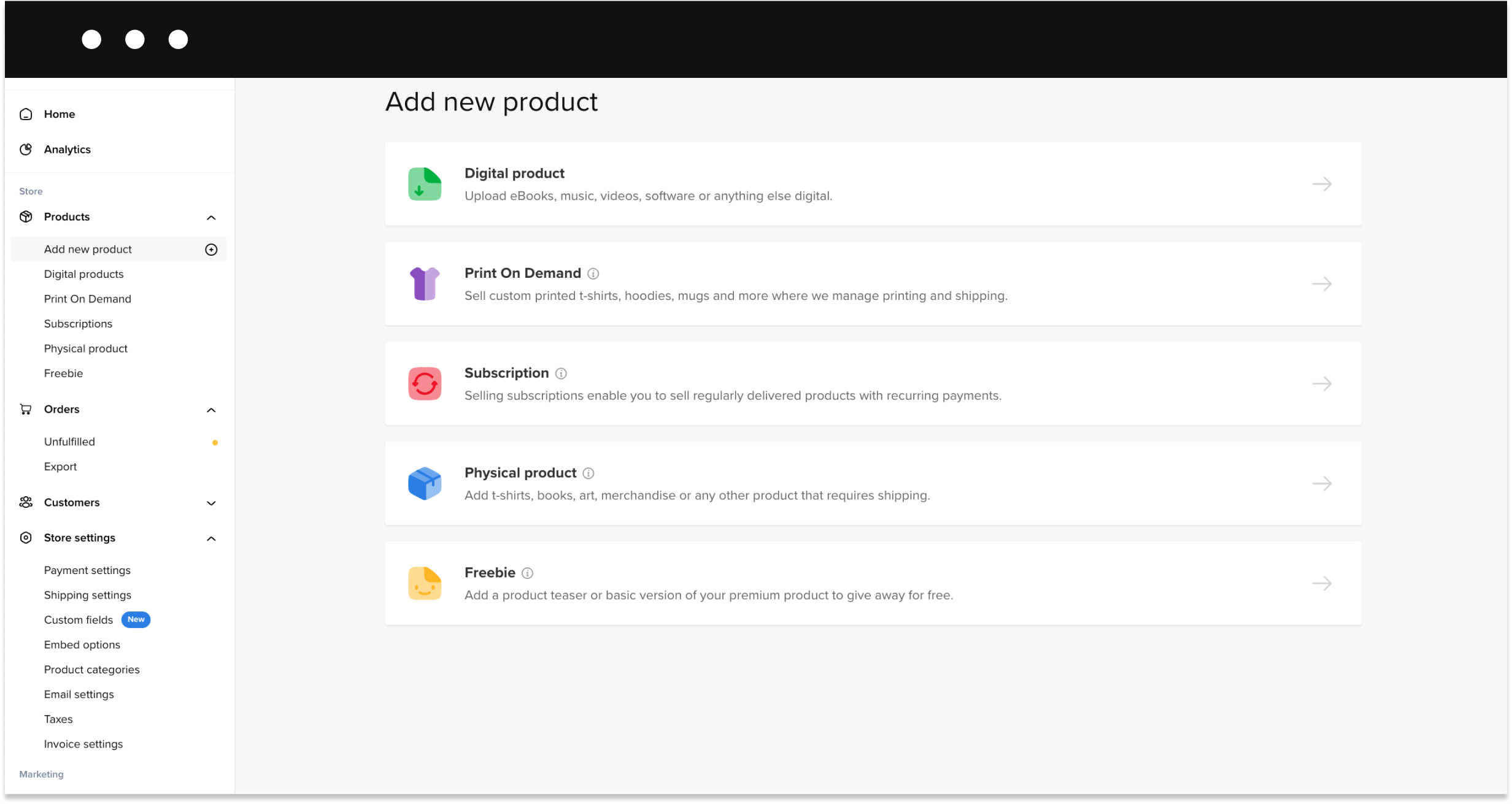
In other words, you can sell digital e-books, physical merchandise, and even online courses all from one place. This versatility is especially beneficial for creators looking to expand their business without being limited to just one product type.
Etsy has a 20MB size cap, Stan Store has a 4GB cap, and Sellfy has a 20GB cap for digital products.
When you’re selling digital products, file size limits can be a make-or-break factor.
Etsy’s got a tight 20MB cap, which is perfect for quick, lightweight downloads like printables, low-res art, or small eBooks. But if you’re looking to sell something heftier—like videos or a dense design file—you’re out of luck.
Enter Stan Store, with a 4GB limit, giving you room to breathe. Think bigger files: online courses, high-quality media, and more.
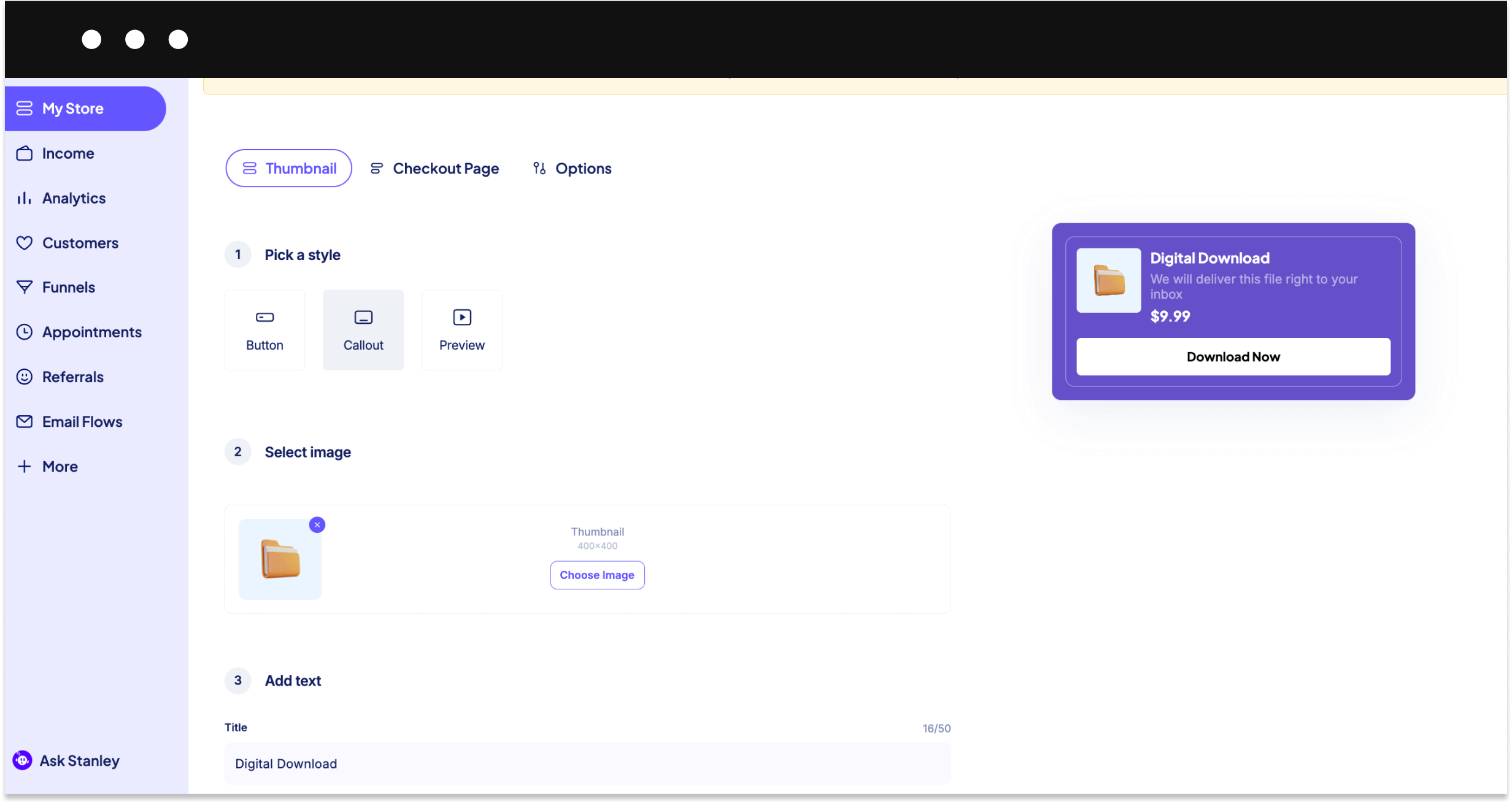
Then there’s Sellfy, pushing the envelope even further with a whopping 20GB cap. That’s where you can really let loose—sell entire video series, huge multimedia projects, or even a complete audio library. Bigger limits mean fewer restrictions. So, pick your platform based on what you’re selling and how much space you need to tell your story.
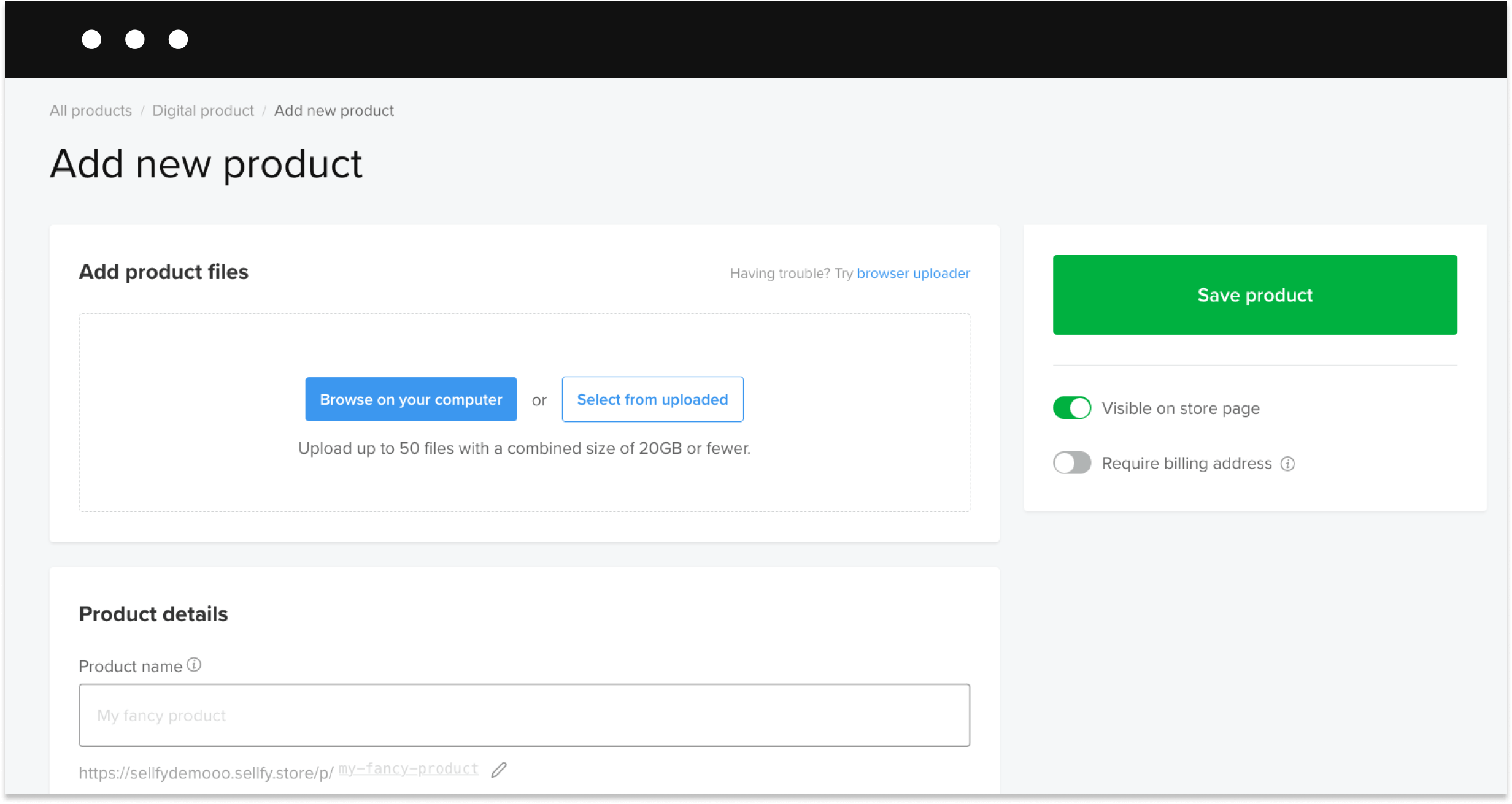
Etsy and Stan Store keep their branding in the spotlight, but Sellfy lets you create a fully white-labeled online store.
If you’re serious about building a brand, you need more than just a virtual shelf for your digital products. Stan Store slaps its branding all over your shop, and you’re stuck with it unless you move to its most expensive plan. It can be quite problematic when your business outgrows this kind of setup.
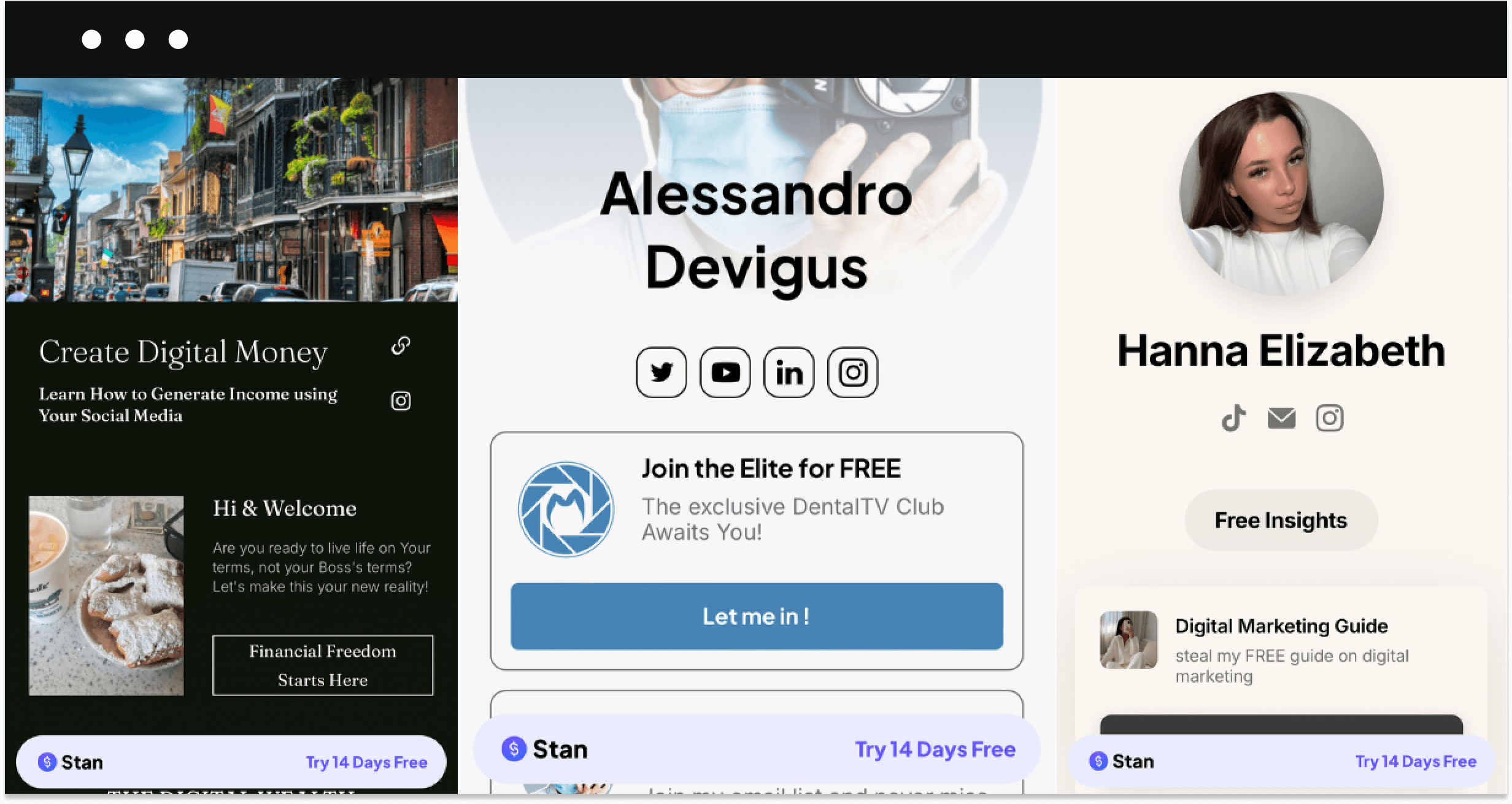
Want to use your own domain? Forget about it with Etsy or Stan. You can’t do it. Sellfy on the other hand, lets you not only add a custom domain but also strip away their branding, so your store looks and feels like it’s yours—not theirs. It’s your brand front and center, not some marketplace’s logo.
| Winner: | ||
Sellfy takes the lead as an all-in-one eCommerce platform with its larger 15GB file size limit, versatile product offerings, and white-label options, making it perfect for creators wanting full control over their online store. While Etsy offers all the benefits of a popular marketplace, its 20MB limit and limited customization make it better suited for smaller digital products. | |||
⭐️⭐️⭐️⭐️⭐️ | |||
Etsy vs Stan Store vs Sellfy: Marketing and eCommerce tools
Etsy and Sellfy specialize in selling digital and physical goods, while Stan Store adds link-in-bio functionality; the list of built-in marketing tools is nearly non-existent on Etsy, pretty short on Stan Store, but much richer on Sellfy.
 | ||
⭐️⭐️⭐️⭐️⭐️ | ⭐️⭐️ | ⭐️⭐️⭐️ |
Sellfy’s and Etsy’s main focus is on selling digital and physical products, Stan Store is also a link-in-bio tool
Despite all the differences between Etsy and Sellfy, they have one thing in common—helping people sell products online.
Etsy is a marketplace for handmade, vintage, and one-of-a-kind items, perfect for creators who want to tap into a community that loves unique finds. Sellfy, though, keeps things simple. You can sell digital products like eBooks, music, online courses, and subscriptions from a slick, customizable online store. It’s a no-frills, all-business platform that lets you do your thing without making things difficult.
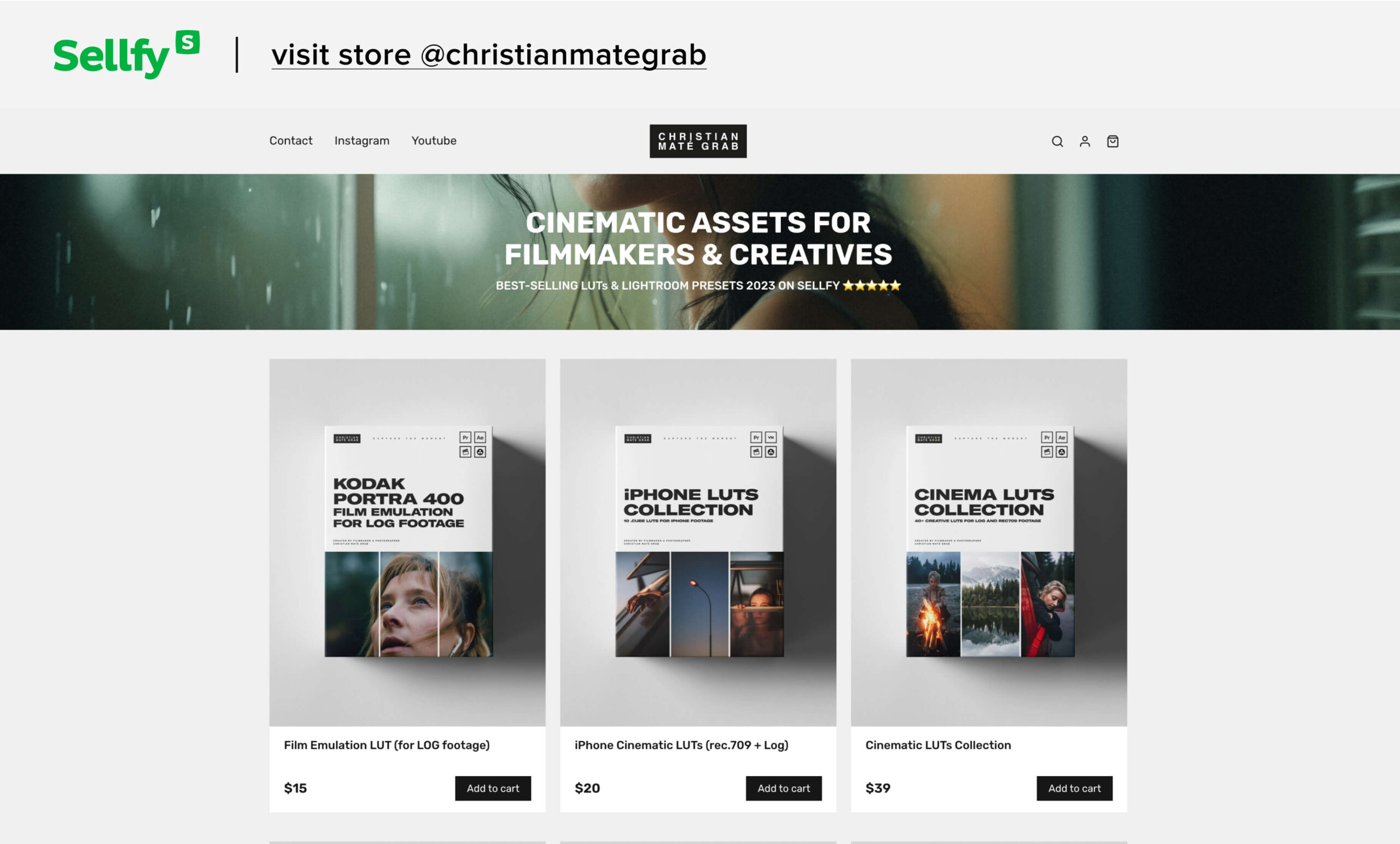
Then there’s Stan Store, which takes a different path. It’s not just a storefront—it’s also a link-in-bio tool. While it takes away from some eCommerce features, it’s not a bad catch for influencers and creators who live on platforms like Instagram and TikTok, giving them a single link where they can sell products, offer services, and showcase content all in one place.

The list of Stan Store’s built-in marketing features is quite short, Etsy’s is nearly non-existent
When it comes to built-in marketing tools, Sellfy immediately stands out as the winner. Even on its cheapest Starter plan, you get the basics: discounts, coupon codes, and email marketing (which we’ll cover in the next section). Bump up to the Business plan (still cheaper than Stan Store’s Pro plan by the way) and you unlock upselling, shopping cart recovery, affiliate marketing, and the option to strip away Sellfy branding.
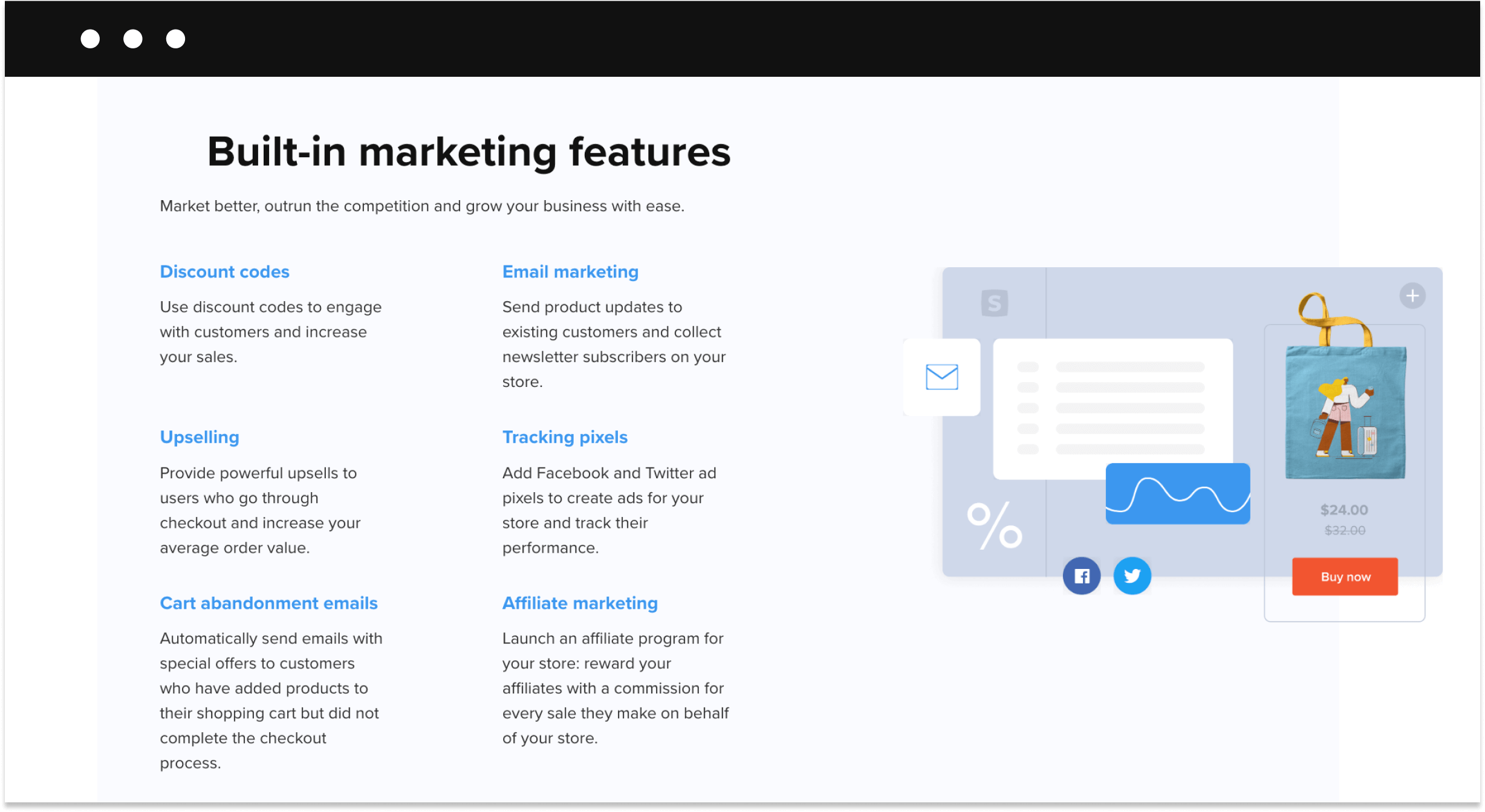
On the contrary, Stan Store’s Creator plan costs the same as Sellfy’s Starter but doesn’t offer a single marketing tool—not even the basics like discounts or email marketing. And forget about tools like cart abandonment recovery—they don’t have it at all.
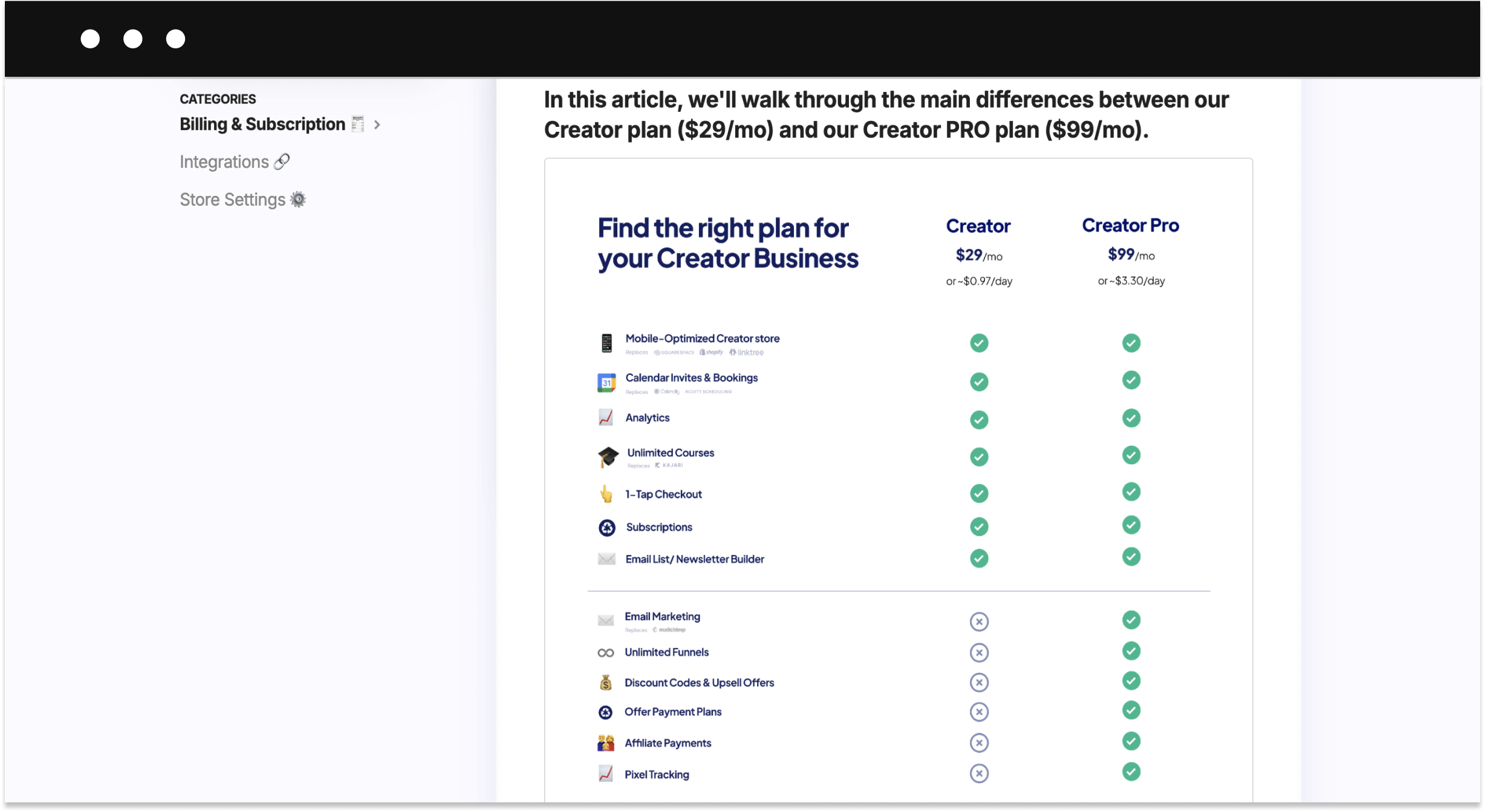
As a marketplace, Etsy gives you some scraps with sales, discounts, and ads, but obviously no such thing as email marketing or cart recovery.

Sellfy and Stan Store will help you with email marketing, Etsy won’t
Email marketing is a crucial tool in eCommerce.
It’s how you keep people coming back, turn browsers into buyers, and recover those almost-sales from abandoned carts. Sellfy knows this and gives you email marketing right out of the gate, even on their cheapest plan. With Sellfy, you can hit up customers with targeted emails, run promos, and even send out automated messages to recover lost sales from abandoned carts.
Stan Store also has a built-in email marketing feature called Email Flows, but you only get access to it once you commit to their most expensive plan. The feature allows you to create an email sequence for prompting upsells as well as offer email broadcasts: emails that go out to your list at a time you choose.
And then there’s Etsy—it doesn’t offer any email marketing tools at all.
| Winner: | ||
Sellfy excels with its rich suite of marketing tools like email marketing and upselling, while Stan Store is more focused on link-in-bio functionality. | |||
⭐️⭐️⭐️⭐️⭐️ | |||
Stan Store vs Etsy vs Sellfy: Customization and design
Etsy maintains a traditional marketplace aesthetic for vintage and handmade sellers; Stan Store and Sellfy keep things simple with designs that fit well with social media styles and digital-era-inspired designs.
 | ||
⭐️⭐️⭐️⭐️⭐️ | ⭐️⭐️⭐️ | ⭐️⭐️⭐️⭐️ |
Sellfy offers more design freedom than Etsy and Stan Store
A great thing about Stan Store is that it allows you to align the looks of your storefront with your brand. You can choose from a handful of pre-designed minimalist themes that are designed to be clean and simple. You can also customize colors, fonts, and your store’s layout to some degree, ensuring it looks good on mobile devices—a crucial feature for creators who rely heavily on social media traffic. However, the customization options are relatively limited—you don’t get much control over the layout or the ability to add advanced features, which can make your store feel somewhat generic.
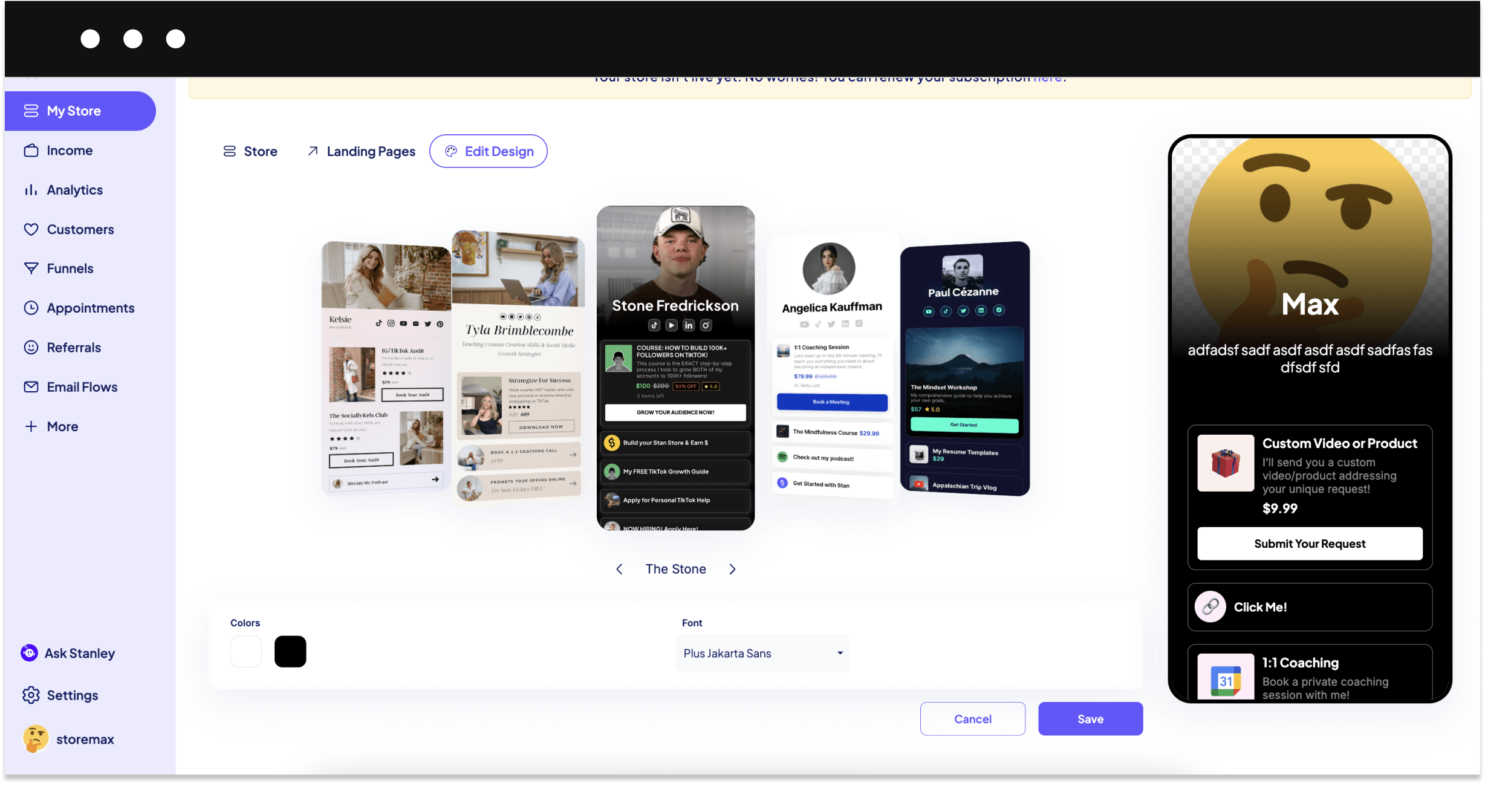
Sellfy, on the other hand, provides extensive design freedom, allowing you to build a complete online store from scratch. With Sellfy, you can create custom pages, organize product categories, and design promotional banners with buttons to enhance user navigation and engagement. Change the layout, colors fonts—everything you need to create a unique look. You also have the option to remove Sellfy branding and choose from a wide array of pre-designed themes, which can be fully customized to match your brand’s aesthetic.

It goes without saying that as a marketplace Etsy’s customization options are more limited; you can update your shop’s banner, add a logo, and write a shop announcement, but the overall structure and design are predetermined, giving you less flexibility than both Stan Store and Sellfy. 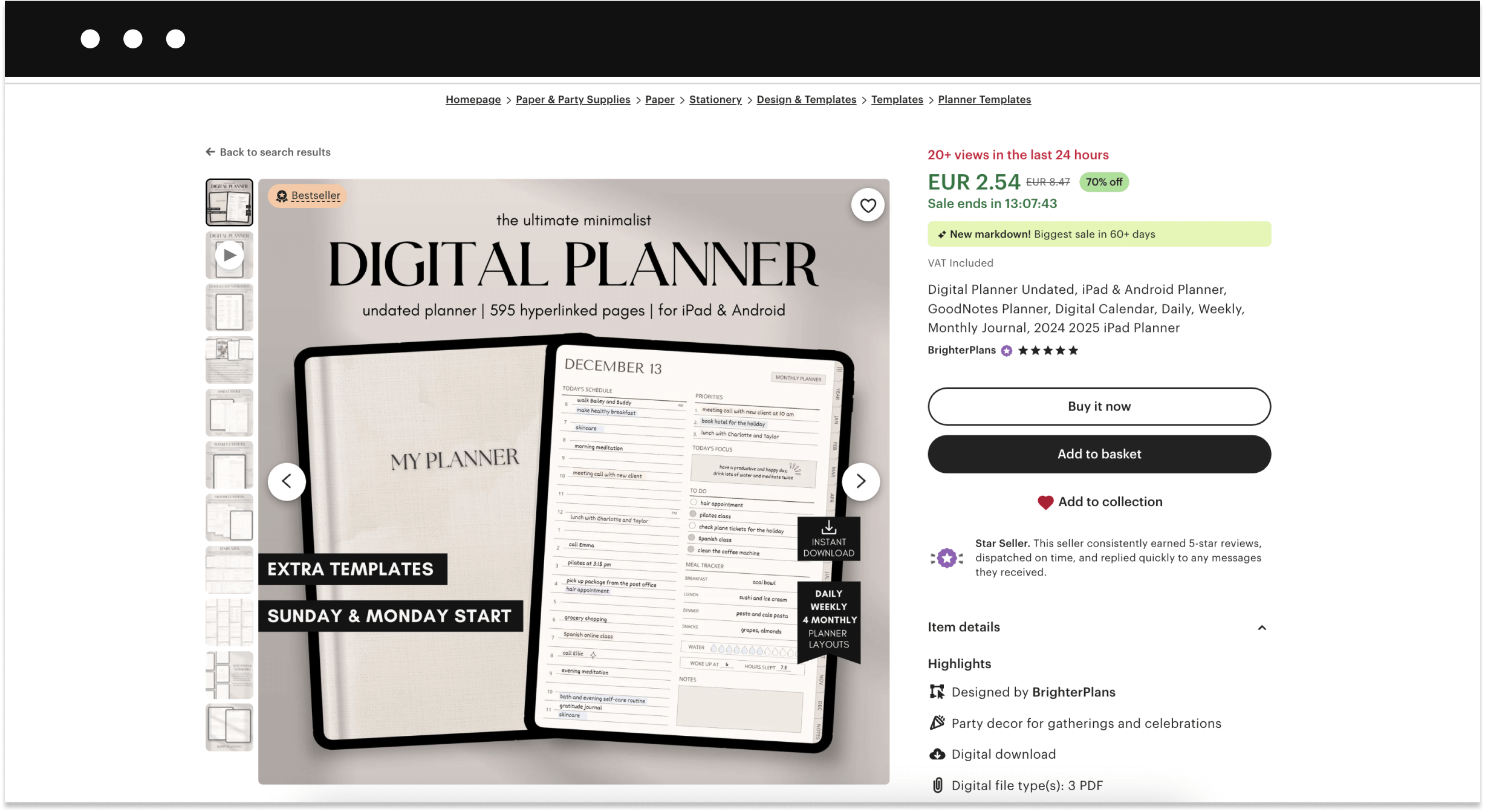
Etsy is the vintage vibe champion for handmade goods
Despite all Sellfy’s and Stan’s customization possibilities, Etsy really gets it when it comes to selling handmade, vintage, and unique finds. This isn’t just another marketplace; it’s a curated experience for people who crave authenticity and craftsmanship. Etsy’s look and feel are like a cozy, well-loved shop where every item has a story.
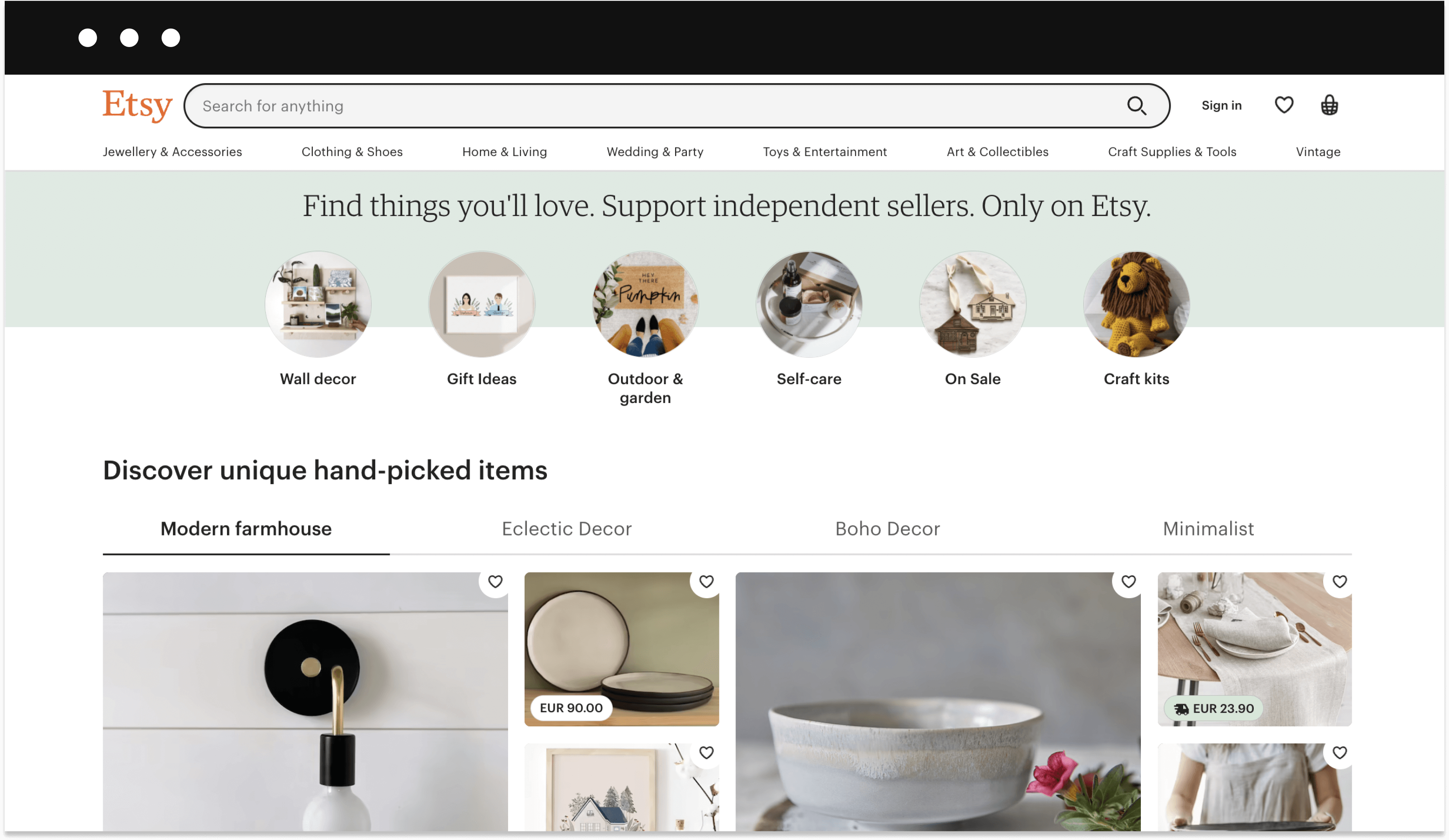
Sure, you can’t go wild with customization, but that’s kind of the point. It’s less about flashy design and more about letting your work shine. Buyers come to Etsy because they want something different, something special. For artisans and vintage lovers, Etsy’s vibe hits just right, and that’s what makes it stand out from the rest.
| Winner: | ||
Sellfy wins for offering the most design freedom, allowing creators to fully customize their store with personalized layouts, fonts, colors, and even the option to remove platform branding. While Stan Store provides some customization options, it can feel a bit boxed in. | |||
⭐️⭐️⭐️⭐️⭐️ | |||
Stan Store vs Etsy vs Sellfy: Transaction fees and pricing
Etsy is free to use but charges a listing fee and a 6.5% transaction fee per sale, unlike Sellfy and Stan Store, which charge monthly fees, with Sellfy giving the best value for the price.
 | ||
⭐️⭐️⭐️⭐️⭐️ | ⭐️⭐️⭐️ | ⭐️⭐️⭐️⭐️ |
Etsy is free to use, while Sellfy and Stan Store charge a monthly subscription fee
When you’re picking a platform for something as serious as selling products online, you’ve got to know what you’re signing up for.
It seems that Etsy makes it easy as it’s free to set up shop, which is why it’s such a hit with small-scale sellers. But don’t get too comfortable; they may sneak in a couple of fees later on. For one, there’s a listing and transaction fee per sale you make.
On the other hand, Sellfy and Stan Store operate on a different model. You pay a monthly subscription fee upfront. which might seem like an upfront cost, but this fee structure can offer more predictable expenses and potentially higher profit margins, especially for those who sell a significant number of products each month. Sure, it’s an expense you must consider, but it’s steady. No surprise costs popping up. Unlike Etsy, Sellfy and Stan Store don’t take a cut from each sale, so you can actually keep more of what you earn.
Etsy charges a listing fee and a 6.5% transaction fee for each item sold
It’s free to open an Etsy store, sure, but once you start listing items, that’s when Etsy gets a piece of the pie. There’s a $0.20 listing fee for every item you post, and that adds up, especially if you’re constantly adding new products or renewing old ones.
Then there’s the 6.5% transaction fee on the total sale price, including the item’s cost, shipping, and any additional options like gift wrapping. This can chip away at your profits, especially if your margins are tight or your items are on the cheaper side. You’ve got to factor these costs in if you want to keep the lights on.
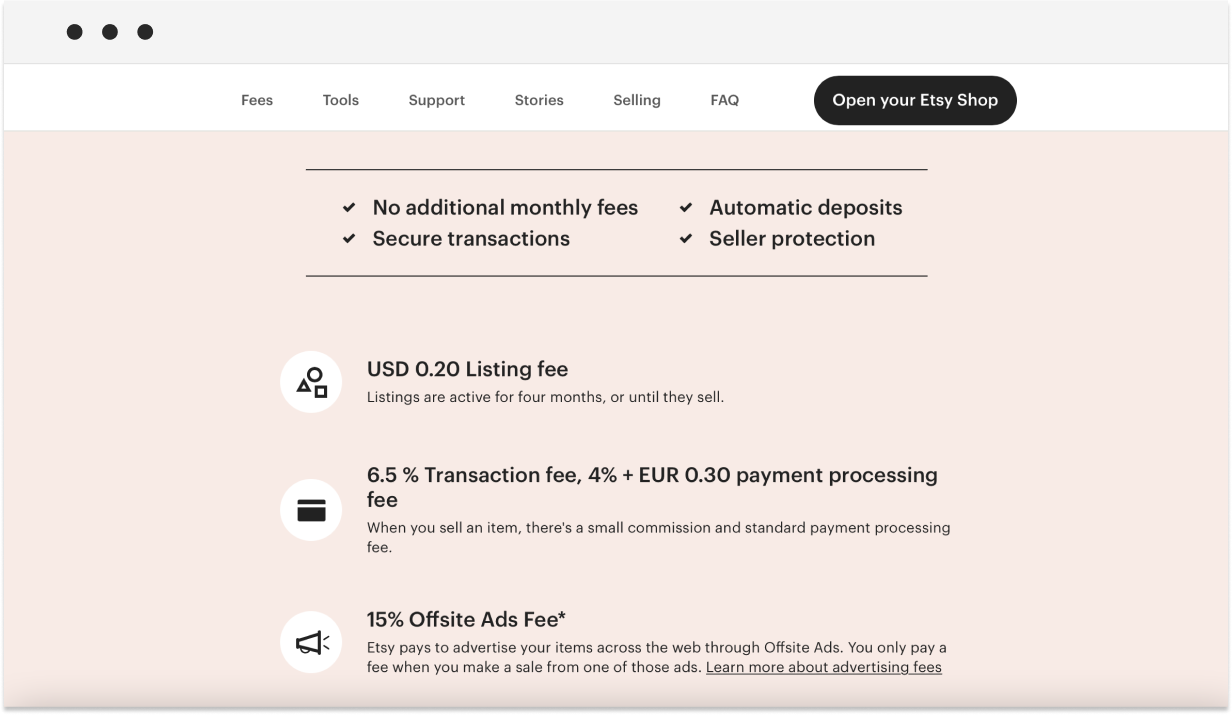
But it’s not all dark and gloomy—despite these fees, Etsy’s large audience and reputation can make it worthwhile for many sellers looking to reach a broad customer base.
Sellfy offers the best value for money
Etsy doesn’t have a subscription fee but the platform charges $0.20 per listing and takes a 6.5% transaction fee on each sale, plus a 3% + $0.25 payment processing fee. Etsy also offers Etsy Plus, priced at $10/month, which provides more shop customization options, listing credits, and discounts on shipping and advertising.
Stan Store offers two pricing plans: Creator at $25/month and Creator Pro at $79/month. The Creator plan includes basic features like a customizable storefront, payment processing, and product management. The Creator Pro plan, priced at $99/month, adds more features such as email marketing, upselling tools, and affiliate marketing. Both plans allow creators to sell digital products, memberships, and services, with seamless social media integrations and no transaction fees.
Creator | Creator Pro | |
$25/month Creator store + Unlimited Courses + 1-Tap checkout + Email list builder | $79/month Everything in Creator + Email marketing + Unlimited funnels + Discounts & Upsells + Affiliate payments | |
Sellfy offers three pricing tiers (monthly/yearly): Starter at $22/month, Business at $59/month, and Premium at $119/month. All plans include unlimited products, digital, physical, subscription, and print-on-demand product support, no transaction fees, store analytics, the possibility to connect custom domains, discounts, email marketing, and a 100% customizable online store. The Business plan adds features like product upselling and affiliate marketing, while the Premium plan offers priority customer support and advanced integrations.
Starter | Business | Premium |
$22/month Online store + Unlimited products + Discounts & Email Marketing + Connect your own domain | $59/month Everything in Starter + Upselling + Cart abandonment + Affiliate marketing + Remove "Sellfy branding + Store design migration | $119/month Everything in Business + Product migration + Priority support |
| Winner: | ||
Sellfy is a solid deal for creators, offering a simple subscription model with no extra fees per sale. It’s great if you want steady costs and more profit. Sellfy handles digital, physical, and print-on-demand products, giving you a ton of flexibility and useful tools to run your store smoothly. While Stan Store is good for social media-focused sellers and Etsy gives you marketplace exposure, Sellfy clearly gives you best value for money. | |||
⭐️⭐️⭐️⭐️⭐️ | |||
Etsy vs Stan Store vs Sellfy: Pros & Cons
Pros | Cons | ||
Simple to set up | Limited physical product support | ||
Monthly subscription without transaction fees | Marketing features are available only on the higher plan | ||
Seamless social media integration | 4GB size cap on digital products | ||
Only basic features for creators that keep it simple | No anti-piracy features | ||
Built-in marketing features | |||
Simple and eye-appealing store themes | |||
A great link-in-bio option | |||
 | |||
Pros | Cons | ||
No subscription fee | Transaction and listing fees | ||
Popular marketplace with an established audience | High competition | ||
Perfect for selling art, handmade, and vintage items | Mostly suitable for handmade/unique items | ||
Simple to set up | No shop customization | ||
A rich community of sellers and seller forums | |||
Pros | Cons | ||
All-in-one eCommerce platform | Monthly subscription fee | ||
Simple to set up, no learning curve | Cart abandonment, upselling, and white-label stores are available on the Business plan | ||
Built-in marketing tools on the Starter plan | |||
15GB size cap on digital products | |||
Built-in anti-piracy features | |||
Built-in print-on-demand | |||
100% customizable storefront | |||
No transaction or listing fees | |||
Strong customer support | |||
Stan Store vs Etsy vs Sellfy: Final verdict
 | ||
Best for: | Best for: | Best for: Influencers who want a simple, social media-friendly platform to sell digital products. |
Stan Store is perfect for creators and influencers who want an easy way to start making money from their digital content, thanks to its simple social media integration. On the other hand, Etsy is great for artisans, vintage lovers, and handmade sellers who want to reach a large audience—though the fees and high competition can be a downside. Sellfy stands out as the most flexible option for digital creators and entrepreneurs, offering a range of product types, more customization, and built-in marketing tools.
Use Stan Store if:
- You’re a content creator or influencer.
- You need fast and easy social media integration.
- You need a link-in-bio tool more than you need an eCommerce platform.
Use Etsy if:
- You sell handmade or vintage items and want access to a large marketplace.
- You prefer a community-driven platform.
- You can handle competition and transaction fees.
Use Sellfy if:
- You’re a content creator creators, entrepreneur, and small business looking for a simple way to start selling products online.
- You want more control over branding and store customization.
- You need built-in marketing tools to grow your business.
Make sure to check out more Stan Store comparison articles:






